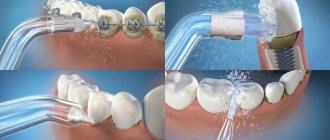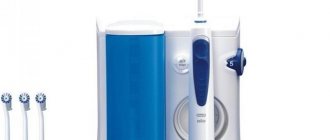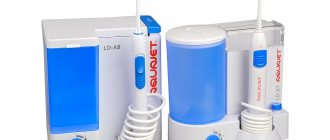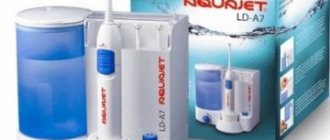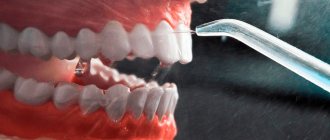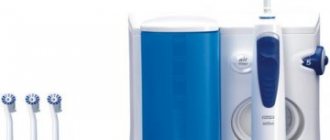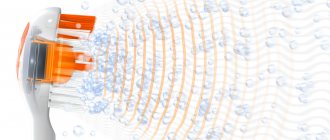From this article you will learn:
- what is an irrigator for and how to use it,
- irrigator – reviews, rating of the best models,
- irrigator – price for 2022.
The article was written by a dentist with more than 19 years of experience.
An oral irrigator is a device that generates a thin stream of water that, under pressure, rinses the interdental spaces from food debris and plaque. In addition, an oral irrigator can reduce the severity of gingivitis, wash out periodontal pockets in patients with periodontitis, and improve hygiene in the presence of bridges or braces on the teeth.
The first irrigator for teeth and gums was developed by an American dentist in 1962. These devices went into mass production thanks to the company, which still produces one of the best irrigators - the Oral-b OxyJet model. In different models of irrigators, the water jet can have different pressure (pressure), have a different number of pulsations (from 1200 to 2000 pulses per minute), and in some models it can also contain micro-bubbles of air. And below we will talk about how to choose an irrigator and what you need to look for.
Stationary and portable irrigators –
According to clinical studies, treatment with a pulsating jet of water (at 1200 pulsations per minute and a water jet pressure of about 490 kPa) leads to the removal of 99.9% of microbial plaque and food debris on the treated areas of the teeth. Accordingly, an important point here will be the technical characteristics of each specific device, on which reviews of the irrigator will depend. The minimum cost of the device starts from 3,000 rubles, and the most popular irrigators are Waterpik WP-100, Oral-b OxyJet, and Donfeel OR-830.
Manufacturers of irrigators position them as a higher quality and simpler alternative to dental floss. But in fact, no irrigator will clean your interdental spaces as much as can be done with proper and regular use of dental floss. The undeniable advantages of the irrigator will be appreciated primarily by patients with braces, bridges, implants, as well as inflammatory gum diseases. But for regular cleaning of interdental spaces, it is better to use dental floss, although at first it is difficult, and the correct technique is not developed immediately.
The operating principle of the irrigator in the video –
How to choose a dental irrigator:
Below we list the main points that it is advisable to pay attention to when choosing an oral irrigator. Particular attention should be paid to the features of the water jet being formed (the number of pulsations, the presence of microbubble technology), as well as to the pressure indicators of the water jet and the presence of smooth adjustments for changing it. In addition, a very important point is the possibility of repairs and the presence of a service center in your city.
Cleaning technology (features of water jet) –
1) The first important point is the presence of pulsations of the water jet. These pulsations are so short (in different models of irrigators this figure ranges from 1200 to 2000 micropulses per minute) that they are unnoticeable. Pulsations create micro-hydraulic shocks, which make it possible to more effectively remove food debris and soft microbial plaque (compared to a water jet without pulsations). There is no particular difference between the models of irrigators that perform 1200, 1400 or 1800 jet pulsations. Those. in this case, “more” does not mean “better.”
2) The second important point is the pressure of the water jet (measured in kPa), i.e. her pressure. The optimal indicator is 500-550 kPa, but there are also more powerful models of irrigators that produce water jet pressure even up to 870 kPa. This can hardly be called a competitive advantage, because... using such pressure is already quite painful for the gums. And patients, even with healthy gums, are unlikely to be comfortable using an irrigator with such a strong jet pressure.
3) The third important point is the ability to regulate the pressure of the water jet. Moreover, it is necessary to have a smooth adjustment, i.e. selection from at least 4-5 preset levels. Reviews of dental irrigators very much depend, among other things, on the availability of smooth adjustments to the water pressure. It is optimal that the minimum level corresponds to a pressure of about 70 kPa, because You will have to start using the irrigator with a small pressure, gradually (from time to time) increasing it.
The fact is that the standard water jet pressure of 500 kPa will be quite painful if you are just starting to use the irrigator. At the same time, lower water pressure will also allow the irrigator to be used not only by adults, but also by children, as well as people with sore gums. But strong pressure can, on the contrary, only increase bleeding of the gums. In addition, the presence of levels with low pressure of the water jet (and with a special nasal nozzle) will allow the irrigator to be used for rinsing the nasal passages with a weak saline solution, for example, in patients with rhinitis or sinusitis.
4) The fourth important point is the presence of microbubble technology. This is an advanced technology developed by , but lesser-known companies have now begun to use it. This technology allows mixing of water flow and air bubbles, i.e. air aeration occurs (air content in water reaches 5%). As a result, the water stream will contain a large number of microbubbles, which will allow us to achieve two important things.
Firstly, when microbubbles explode, they also create microhydraulic shocks, which contribute to even more effective removal of food debris and plaque. And secondly, air microbubbles saturate the water with oxygen, which has a bactericidal effect on pathogenic microflora. This is especially important for patients with gum disease, such as gingivitis or periodontitis.
5) The fifth feature is the presence of different modes. Most irrigators have only 1 operating mode in the form of a pulsating monojet, but some models have additional modes. For example, in the Oral-b OxyJet irrigator, in addition to the standard mode, there is also a “turbo flow” mode. When you select the “turbo flow” mode, the built-in mini-turbine in the nozzle is activated, which begins to spin at a speed of 8000 rpm. As a result, a spiral-shaped jet stream is formed, which is optimal for gum massage.
Conclusions: we hope that now it is clearer to you which is the best oral irrigator to choose. Of course, there should be a jet pulsation of at least 1200 pulses per minute, as well as smooth adjustments of the jet pressure - from 70 kPa (some models even from 35 kPa) to approximately 500-650 kPa. Well, the presence of microbubble technology is very desirable. Below we will tell you what else you should pay attention to if you decide to buy an irrigator for your teeth and oral cavity.
Types of attachments for irrigators –
Some irrigators have universal nozzles, others have whole sets of nozzles for all kinds of cases. In addition to universal ones, there are attachments for cleaning the tongue, for washing periodontal pockets, attachments for cleaning orthodontic structures (braces), attachments for cleaning artificial crowns and bridges, and attachments for cleaning implants.
Also, some models have special nasal nozzles that allow you to rinse the nasal cavity with an irrigator, which is sometimes necessary in the treatment of rhinitis (including allergic origin) and sinusitis. Most manufacturers produce attachments that have different color indicators. This is very convenient, because... Each family member will have a nozzle of its own color, and will never confuse it with other people's nozzles.
Examples of nozzles –
Availability of a service center in your city –
Those who want to buy an oral irrigator online may encounter a lack of a service center. For example, service stations are only available in the largest cities, and to replace a defective irrigator you will need to send it by mail at your own expense. But this option is only possible during the warranty period.
Possibility of service after the warranty period expires –
Reviews of oral irrigators are often negative precisely because many cheap models are not repairable. It’s not scary if a defect is discovered during the warranty period (in this case, the broken device is simply replaced with a new one), and in this case you will only have to spend money on postage costs to send the faulty irrigator to the seller.
But if the irrigator breaks down after the warranty period has expired, then the non-repairable model can be immediately thrown away, because the service will simply refuse to repair you. You should pay close attention to this point, because... Power surges and too hard water (both of which are the norm for Russia) can affect the operation of the device.
What to look for when choosing
When choosing a toothbrush with an irrigator, pay attention to the following parameters:
- The volume of the container for water or liquid. Usually it is enough to carry out one cleansing procedure.
- Priors differ in power. The higher it is, the more intense the effect on tissue.
For people with diseased gums, strong exposure can be harmful. You should not allow your gums to bleed.
- The more operating modes, the more convenient it is to choose the power that matches the sensitivity of your teeth. The mode switch is located on the body. By moving it, choose the most effective and at the same time gentle.
- The presence of additional attachments will provide better care for crowns, implants and bridges.
- The device is small in size and can be taken with you on vacation, travel and business trips
- The higher the battery capacity, the longer it can work. This is especially important in places where there is no way to connect it to the network. Advantages and disadvantages
Advantages of irrigators with a toothbrush function:
- Cleans food debris and plaque, protecting against caries
- During the procedure, the unit massages the gums, improving blood circulation. Thus, it protects them from gingivitis and periodontal disease, which can lead to tooth loss
Flaws:
- Does not connect to water supply like conventional irrigators
- Teeth cleaning attachments do not rotate around an axis, so they are less effective at cleaning plaque
- Most models do not have contactless charging
Oral irrigator: price 2022, rating
Below we will present you with an analysis of irrigators from several manufacturers, which we consider the best on the market. Of course, these include Waterpik, Oral-b, Panasonic, Donfeel and some others. By the way, it is worth noting that in recent years the price of irrigators has remained virtually unchanged, or even become lower. For example, 4-5 years ago the Oral-b OxyJet irrigator cost about 10,000 rubles, but now you can buy it on sale, starting from 5,500 rubles.
We would also like to draw your attention to the fact that a huge number of inexpensive irrigators of absolutely unknown brands are now sold on the Internet, the main problem with which is the following - 1) the water pressure does not correspond to the declared one, 2) the use of low-quality o-rings made of cheap silicone leads to rapid disabling the device. Below we will first tell you about high-quality stationary irrigators - after which we will move on to portable models.
What liquid to pour into the irrigator
To refill the device, liquids are used, which, depending on the composition, have one or another effect.
Main types of compositions:
- Fluoridating. Aimed at strengthening tooth enamel;
- Therapeutic and prophylactic. Contain antiseptic additives, mostly of plant origin;
- Refreshing. The composition of such liquids includes menthol and eucalyptus, which help freshen breath;
- Antiperiodontal. Contains various biooxidants and anti-caries components;
- Hypoallergenic. They have a neutral composition, suitable for people prone to allergic reactions.
Irrigator Waterpik (Waterpik) –
Waterpick irrigators are developed (USA) and it is one of the most famous brands of irrigators in the world. However, the assembly of the devices is carried out in China. The manufacturer offers a fairly wide range of stationary models, but they all have similar characteristics. The characteristic of the water jet is a monojet with 1400 pulsations per minute, the water pressure is adjustable from 70 to 550-690 kPa (depending on the model). Unfortunately, microbubble technology is not used in Waterpik irrigators.
The flagship model is the Waterpik WP-100 EU Ultra irrigator, the price of which will be about 6,500 rubles. The most expensive model “Waterpik WP-660 EU Ultra Professional” will cost about 8,000 rubles (this model is distinguished by the presence of a second “gum massage” mode, as well as a wider selection of water pressure levels). The model that has the minimum cost is “Waterpik WP-70 EU Classic” from 4,500 rubles, which has fewer nozzles included + only 5 levels of water pressure adjustment.
Examples of Waterpik irrigators and attachments for them -
Let me summarize the pros and cons of Waterpik - 1) these are high-quality devices whose water pressure corresponds to the declared one, 2) a 2-year guarantee, which also confirms the reliability of these devices, 3) a very wide range of attachments for all cases - including periodontal ones for the care of gum pockets, attachment for braces, attachment for bridges, etc.
Disadvantages - the lack of microbubble technology, as well as the lack of a network of service centers in Russia (i.e. if a breakdown occurs during the warranty period, you will have to send the irrigator to Moscow at your own expense, and after some time they will simply send you a new device) . If the breakdown occurs after the expiration of the warranty period, then service is not possible and you will only have to throw away your device, because Apart from replacing attachments and batteries, the devices cannot be repaired.
Flaws:
- The energy source is too small to create the required water jet pressure.
- The need to frequently replace batteries or charge the battery.
- The volume of water is not enough to fully clean the oral cavity.
- Flow irrigators are attached to a water tap and use the pressure of the water supply system. Special tap valves allow you to regulate the fluid pressure.
- Mechanical types of irrigators are now rarely used. These are devices in which the pressure required to produce a jet is achieved by mechanical action on the piston. There is a key on the body of the device that is pressed to increase the pressure in the vessel with the liquid. The efficiency of such a device is low
- Tap water mixed with chlorine and heavy metal salts enters the oral cavity.
- There is no pulsation mode.
- Often the water pressure is not enough for effective cleaning.
- Modern models use the latest fine-bubble cleaning method, which is considered the most effective.
- The pulsation mode also promotes the rapid removal of microparticles of organic substances from teeth and orthopedic structures.
Irrigator Oral-B (Braun~Oral-B) –
Oral-b is the world leader in electric toothbrushes and irrigators, and it was the company that developed the microbubble technology we discussed above. The Oral-b company produces only 1 model - the Oral-b Professional Care OxyJet MD20 irrigator. This irrigator has 2 operating modes: “monoflow” and “turboflow” (in both modes, the water jet has 1200 pulsations per minute, and the water pressure is adjustable from 150 to 600 kPa).
The “turbo flow” mode is distinguished by the fact that in this mode, a turbine built inside the nozzle (rotating at a speed of 8000 rpm) is activated in the nozzle, which creates spiral-shaped turbulence in the liquid flow. This mode is especially suitable for gum massage (24stoma.ru). Plus, in both modes, microbubble technology is active, which allows you to better clean teeth, bridges and braces from plaque and food debris, and also, thanks to the saturation of water with oxygen, have a bactericidal effect on pathogenic microflora in case of gum disease.
Irrigator Oral Bee and attachments for it -
Additional advantages are a 2-year warranty, a wide network of service centers, as well as the possibility of service even after the warranty period has expired. To summarize, this is a high-quality, reliable device that will serve you for many years. Cons - the kit includes only universal attachments, which are sufficient in all cases except one. For example, the Oral-b OxyJet irrigator is perfect for cleaning between teeth, in the presence of braces or bridges, as well as in cases of gingivitis or mild periodontitis.
But, if you have moderate or severe periodontitis (i.e., if you have deep periodontal pockets), then it would be optimal to use a special periodontal tip with a narrow spout. This tip can be lightly inserted into the upper part of the periodontal pocket, which makes rinsing deep periodontal pockets more effective. Irrigators have such attachments, for example, Waterpick and Donfil.
Nozzles and their types
The irrigator comes with one or more attachments. Remember that each family member should have their own nozzle. Nozzles can be purchased and changed. They come in several types.
- The standard
brush head is suitable for cleaning healthy teeth and gums. - An orthodontic
attachment is needed to remove plaque under braces and under the gingival margin. For these purposes, you can use a standard attachment, but the orthodontic one is more convenient. - A periodontal
nozzle with a thin soft rubber tip directs the jet beyond the gingival margin and into the periodontal pockets. It should not be used at maximum power - otherwise it may suddenly fly off or tear. - Nozzle for implants
, crowns and bridges - with 3 tufts of bristles for easy cleaning of structures. - The tongue cleaner
removes plaque from the tongue and cheeks, eliminating the cause of the unpleasant odor. - For additional plaque removal there is a brush attachment
. But it does not replace a regular toothbrush. - A nasal nozzle
is needed to irrigate the nasal cavity during the treatment or prevention of rhinitis and sinusitis.
Standard attachments need to be changed approximately every six months, and periodontal, orthodontic and brush attachments - every 3 months. Remember that each family member should have their own nozzle.
Irrigator Donfeel (Donfil) –
The Russian company Donfeel produces a wide range of irrigators, and we note that they are of fairly high quality, reasonable price and good functionality. The flagship model, the Donfeel OR-800 irrigator, generates a stream of water with pulsations from 1250 to 1700 per minute, and the water pressure is adjustable from 0 to 680 kPa. This device is also distinguished by the presence of 2 operating modes (standard + gum massage), 10 levels of water pressure adjustment, and the kit includes 5 nozzles.
Moreover, this device can also be used to rinse the nose (together with a special nasal tray and a weak saline solution). The warranty is 1 year, and the cost is only about 3800 rubles. This device has only 1 minus - the lack of microbubble technology. But this technology is implemented in another model - the Donfeel OR-840 AIR irrigator. This is an inexpensive and good irrigator at a price of about 3,400 rubles, and what distinguishes it from the flagship model is that it has only 1 standard operating mode, as well as only 5 levels of water pressure adjustment.
Donfeel irrigator models –
Sets of attachments for Donfeel irrigators –
To summarize, Donfil irrigators have been produced for more than 13 years, and during this time they have shown their reliability. In addition, the manufacturer has a wide network of service centers throughout Russia, and provides service even after the warranty period has expired. It is also necessary to say about the wide range of attachments, among which there are standard, periodontal, for cleaning braces, for cleaning the tongue, for implants, as well as special nasal attachments (for rinsing the nose for sinusitis and rhinitis).
The best inexpensive irrigators (up to 1500 rubles)
In fact, the demand for irrigators has increased significantly over the past few years. Now this useful and effective device can easily be used at home. However, many still doubt the need to purchase this device. Especially for those who want to study and try an irrigator, we offer the TOP 4 best budget models, the cost of which does not exceed one and a half thousand rubles.
FFT-IFI-2000
A good irrigator from the budget segment.
FFT-IFI-2000
The rating of inexpensive irrigators opens with a model from the American brand FFT (Favorite For Teeth) - FFT-IFI-2000 (665 rubles). The key feature of this device is its low cost - you can buy it for six hundred rubles. This is a mechanical irrigator, so it does not need to be recharged, which can be considered a definite advantage. The capacity of the reservoir is, for obvious reasons, very modest - only 90 ml, which, nevertheless, will be enough for one-time use by one person. By the way, the kit includes two replaceable nozzles - one for jet cleaning of the oral cavity, and the other is intended for nasal use.
Main characteristics
- Purpose: for adults
- Irrigator power: none
- Tank capacity: 90 ml
- Jet pressure: 310 - 517 kPa
- Switch on the handle
- Dimensions (WxDxH): 37x28x25 cm
- Weight: 94 g
Video review
Advantages:
- Compact and can be used everywhere.
- Does not require power, the operating principle is mechanical.
- Suitable for nasal use as well.
- Convenience and ease of use.
Flaws:
- Weak pressure.
- Small tank volume.
- The jet of liquid released is too wide.
Irrigator Panasonic EW1611 –
Another great device with microbubble technology is the Panasonic EW1611 irrigator.
In addition to a water jet with a pulsation of 1900 pulses per minute and a pressure of up to 646 kPa, this device implements ultrasonic technology for creating microbubbles. The device also has 10 water jet pressure modes. The set includes 2 universal attachments. The warranty is 2 years. It should be noted the high cost of the device - from 9,500 rubles, but you will immediately notice a completely different quality of cleaning (especially in comparison with cheaper devices below). Ultrasonic irrigator Panasonic EW1611 –
This particular model of irrigator was purchased by the author of the article in February 2022 (for his 65-year-old mother) - photo above. You could see a video of the Panasonic EW1611 irrigator in operation (slow motion) at the beginning of this article. I can only leave positive reviews for this oral irrigator, because... According to my mother, he copes with his function perfectly, and the “patient” was very pleased with his work. In addition, during 8 months of use there were no technical problems.
Types of irrigators by type of jet supplied
- Monojet. They represent a continuously supplied flow having the same power and direction;
- Turbo flow with pulsation. The most modern technology, characterized by the supply of micro-hydro-impact jets that target specific areas.
The optimal level of jet frequency is considered to be 1200 pulsations per minute. Some models allow you to reproduce frequencies in excess of 1700 beats.
The classic volume of the reservoir, designed for one session (one cleaning) is 150-200 ml of water for portable and 500 ml more for stationary irrigators. The correct selection of the cleaning attachment plays an important role.
A few more models outside the rating -
Below we will present several more models of irrigators that you can find in online stores. They are generally good too, some even have a 2-year warranty, but they do not have modern micro-bubble technology, which significantly increases the cleaning power of a regular pulsating stream of water.
a) Irrigator B.Well wi-922 / wi-933 –
You can also see B.Well irrigators on sale. Among the stationary models of this company are 1) the B.Well wi-922 irrigator, as well as the B.Well wi-933 irrigator. The water jet of these models has a pulsation from 1250 to 1800 per minute, the pressure of the water jet is adjustable from 207 to 862 kPa. Their cost is 3500 and 4700 rubles, respectively. They differ in that the second model can work not only from the network, but also from the built-in battery, and it is also distinguished by an 800 ml water tank (all other irrigators have a 600 ml tank). Another couple of advantages are a 2-year warranty and a wide range of attachments. They don't have microbubble technology.
Irrigators B.Well wi-922/ wi-933 –
b) Irrigator Revyline RL-100 –
The Revyline RL 100 irrigator has similar characteristics to the B.Well WI-922 irrigator. The pulsation frequency of the water jet is from 1200 to 1700 per minute, and the level of liquid pressure can be adjusted from 210 to 870 kPa (10 operating modes). 2-year warranty, and a wide range of attachments, including standard, periodontal, for cleaning implants, bridges and braces, as well as tongue cleaning. There is no microbubble technology.
Irrigator Revyline RL-100 –
c) Irrigator Aquajet LD-A8 (Aquajet) –
Another option is the Aquajet irrigator - model Aquajet LD-A8. The pulsation frequency of the water jet is 1200 per minute; it can be noted that the range of liquid pressure levels is not very good - from 290 to 810 kPa. Three options for nozzles, one of which has a thin flexible tip (this can be convenient for safely rinsing periodontal pockets). It should be noted that the device is quite bulky. There is no microbubble technology. Cost from 3500 rubles, warranty – 1 year.
Pulse irrigator: main features
Pulse irrigators, unlike mono-jet irrigators, supply water not with a uniform stream, but with a pulsating one. The devices create a pulsation of 1200 hydraulic shocks per minute, which quickly removes food debris from the mouth. In addition, these micro-impacts help separate plaque from the teeth, causing them to become lighter. The impulses created by the device massage the gums, thereby stimulating blood flow, promoting tissue healing and reducing bleeding. This protects a person from various dental diseases, such as gingivitis and caries.
Stationary irrigators for teeth: results
In our opinion, if the high price does not bother you, the best option would be the Panasonic EW1611 irrigator. It is in this irrigator that the most modern microbubble technology (ultrasonic) is implemented, which, together with pulsations and optimal pressure of the water jet, ensures the highest quality cleaning of the teeth and oral cavity. More affordable options with microbubble technology would be the Oral-b OxyJet and Donfeel OR-840 AIR devices.
And we would recommend that almost all patients make a choice between these devices. Moreover, the choice between them must take into account some points. For example, if you need an irrigator, including for rinsing the nose, or you have deep periodontal pockets, the “Donfeel OR-840 AIR” will be optimal (since it has both a nasal and a specialized periodontal nozzle for rinsing pockets) . But if you have gingivitis or just initial periodontitis, then the universal nozzles of the Panasonic and Oral-b irrigators will be enough.
As for Waterpick irrigators, these are high-quality devices, but with a number of disadvantages. They are not cheap, there is no network of service centers across Russia, and post-warranty service is not provided at all. In addition, if you want super-high-quality cleaning of your teeth from plaque and food debris, and also if you have gingivitis or periodontitis, you need an irrigator with microbubble technology (ultrasonic).
The fact is that bursting air bubbles create micro-hydraulic shocks, which significantly increase the cleansing properties of a pulsating water jet (not only on the surface of the tooth crown or in the interdental spaces, but also in periodontal gum pockets). And moreover, the presence of bubbles leads to the saturation of water with oxygen, which has a bactericidal effect on the microflora of the gum pockets, which is very important for patients with gingivitis and periodontitis.
Which irrigator is better - with a water tank or with a connection to a tap?
Most devices usually come with a liquid container, the volume of which ranges from 600 to 1000 milliliters for stationary devices and from 120 to 250 milliliters for road irrigators. If you are buying a water irrigator for personal use, a portable model is also suitable for you. The main thing is that the reservoir is not the smallest, approximately 140–160 milliliters, otherwise the irrigator will have to be “refilled” during the cleaning process. For a large family, the Hydro Floss Kitty Waterjet with a large tank is ideal - there will be enough liquid for several cleanings.
Among irrigators there is also a separate subtype with connection to a water supply system. It is sold together with an adapter, which is attached to the faucet and connected with a hose to the handle of the device. This unique device is considered the most compact and does not require connection to the mains. However, there are also disadvantages. Firstly, before each use you will have to screw the adapter, which will require some effort and time. And secondly, you will not have the opportunity to pour boiled or filtered water or balm into the device, which may affect its operation. However, the inventors of the device found a way out of the situation and released special capsules with antibacterial liquid, which are installed directly into the nozzle.
Portable irrigators for travel –
If you want to save space in the bathroom or be able to take a irrigator with you on a trip, portable models of irrigators are suitable for you, but keep in mind that high-quality portable models are much more expensive than stationary ones. Cheap portable irrigators most often have 1) the water jet pressure does not correspond to the declared one, 2) poor tightness, 3) low service life and non-repairability, 4) lack of microbubble technology.
Another feature that you should pay special attention to is that their water tank is only 140 to 200 ml (for stationary ones, most often 600 ml). This means that you will have to refill the water tank many times during one procedure. You can see how this is done in the photo below. We definitely recognize the Panasonic EW1511 and EW1411 irrigators as the best portable devices.
Portable models of irrigators –
1) Panasonic irrigators –
These irrigators have the richest functionality, microbubble technology (ultrasonic cleaning), as well as a high degree of reliability. The most advanced model is the Panasonic EW1511 irrigator. Main characteristics: water jet pressure from 195 to 647 kPa (5 adjustable power levels), jet pulsation 1600 per minute, 200 ml reservoir - enough for 60 seconds of continuous use (in the highest water pressure mode), 2 nozzles included, 2 guarantee of the year. Cost from 9000 rubles.
Irrigator Panasonic EW1411 – maximum water pressure 590 kPa, 1400 water pulses per minute. The most basic difference between this irrigator is the presence of 4 operating modes - 1) pulse mode with a jet pressure of 590 kPa, 2) continuous jet mode without pulses with a pressure of 590 kPa, 3) “normal” air mode - with a pressure of 390 kPa, pulsed water supply and air microbubbles, 4) soft air mode - with a pressure of 200 kPa, pulsed water supply and air microbubbles. Cost from 8000 rubles.
2) Irrigators Oral-B Aquacare Pro-Expert 4/6 –
Above, we spoke quite highly of the Oral-B stationary irrigator - the Oral-b OxyJet model, and indeed it is an excellent oral irrigator. Portable irrigators of this or “Oral-B Aquacare Pro-Expert 6” are also available with microbubble technology and pulsed water supply (1400 pulses per minute). But we cannot recommend them for purchase, and the point here is the rather low water pressure! Moreover, the water pressure becomes higher if you use this irrigator with the lid slightly open to fill the water tank, which is really not very convenient.
Of course, this indicates an engineering error (when the pump operates, something close to a “vacuum” is created in the water tank), and therefore the pump pumps water slowly. Those. In order for the water pump to pump at a level of 500-600 kPa, there must be a small technical hole in the upper part of the tank to draw in a volume of air equal to the volume of water used. In general, all this indicates an engineering mistake by the manufacturer. And you’d better turn your attention to portable irrigators from other companies, or purchase its stationary version.
3) Irrigator “CS Medica AquaPulsar CS-3 Air+”
Another device with microbubble technology is the CS Medica AquaPulsar CS-3 Air+ portable irrigator. Characteristics: maximum jet pressure 590 kPa, pulse frequency 2000 per minute, tank volume 130 ml. The set includes 4 attachments, including standard, periodontal, for braces and for sensitive gums. In principle, this is a very interesting irrigator at a price of about 3,500 rubles, and in its functionality (operating modes) it is somewhat reminiscent of Panasonic.
So, this irrigator has 3 operating modes: 1) Intensive mode - with a jet pressure of 590 kPa, pulsed water supply, without microbubbles, 2) NORMAL Air mode - with a jet pressure of 390 kPa, pulsed water supply and air microbubbles, 3) SOFT mode Air – with a pressure of 200 kPa, pulsed water supply and air microbubbles.
Conclusions: In general, the choice of portable irrigators with ultrasonic (microbubble) technology is limited to just a few manufacturers. Most other manufacturers produce portable irrigators with only regular pulse water supply, which is certainly not optimal. It’s better not to buy portable devices that are cheap in terms of functionality, such as the Xiaomi Soocas W3 irrigator, although on the other hand, even such models are still better than nothing at all.
Irrigator care
Here are a few rules for caring for your irrigator.
- Do not touch the charger with wet hands
. - Do not allow the plugged-in device to come into contact with water
. - Carefully monitor the integrity of the cord
. - Do not wipe the housing with alcohol
. - Do not place the device near heating devices
. - Fill the reservoir only with water and special balms
for the irrigator. - While the irrigator is operating, do not hold the pause button for long
- the motor may burn out. - Use only attachments recommended by the manufacturer
. - If you take the irrigator on the road in winter, there should be no water in it
- otherwise it will freeze and the device will break. To remove all the water, turn on the irrigator. Let it run until all the liquid comes out.
Indications for the use of irrigators –
Above, we tried to explain in detail which is the best irrigator for teeth, as well as what characteristics you need to look at first. But for which groups of patients are irrigators absolutely necessary? On the oral irrigator - reviews from patients and dentists say that these devices are necessary:
- If you don't use dental floss, dental floss is designed to clean the spaces between your teeth, where food particles first remain after eating.
Using only one toothbrush does not allow you to completely remove food debris and plaque from the interdental spaces, and that is why caries most often develops on the side surfaces of the teeth. Normally, dental floss should be used after every meal. Additionally, flossing requires skill and can be challenging at first. An irrigator is essentially a replacement for dental floss, but it should be recognized that dental floss is certainly better at removing food debris and plaque from the interdental spaces. Therefore, if you don't have braces, bridges or gum disease, then a waterpik is a slightly less lazy alternative to regular dental floss.
- Inflammation of the gums - inflammatory diseases of the gums (gingivitis, periodontitis) are always associated with insufficient oral hygiene, as a result of which pathogenic plaque bacteria lead to the development of inflammation in the gums. An irrigator in addition to a toothbrush will certainly improve the removal of plaque and food debris, which will have a beneficial effect on the condition of your gums.
And if patients with gingivitis need irrigators to prevent the development of periodontitis, then for patients with periodontitis, purchasing an irrigator is already a vital necessity. With this disease, so-called periodontal pockets (periodontal pockets) are formed between the gums and the roots of the teeth, in which a large amount of infection is present. For such patients, it is very important to regularly rinse the periodontal pockets - and for this you can add a special “irrigator liquid” to the water (or use a slightly salted water solution).If for mild gingivitis or periodontitis, a regular universal attachment will be enough for you, then for more severe forms of periodontitis (the presence of deep periodontal pockets), it is advisable to use special periodontal attachments that have a thin elastic spout. The latter can already be carefully introduced into the upper part of the periodontal pocket, which will allow all the purulent contents to be washed out of it in a stream.
Periodontal tip:
Important: for such patients, irrigators are needed exclusively with microbubble technology, the presence of a pulsating water jet, and an additional soft operating mode (when the pressure of the water jet is only about 200 kPa). Those. The interdental spaces themselves are washed with a universal nozzle - at a standard pressure of 500-700 kPa, and targeted rinsing of each periodontal pocket - using a periodontal nozzle and a soft operating mode.
- For patients with braces, the presence of non-removable orthodontic structures such as braces seriously complicates hygiene, and the use of dental floss in this case turns into a complete nightmare. An irrigator is vital for such patients, and it must also have microbubble technology and a water jet pressure of at least 550-600 kPa.
- In the presence of bridge-like prostheses, the supports of the bridge are ordinary artificial crowns that are fixed on the ground teeth. But the intermediate part of the bridge, which replaces missing teeth, has a rinsing space from the inside (this is where food debris accumulates and tartar forms). An irrigator is better than a toothbrush for cleaning bridges from the inside.
- Prevention of caries in children and adults - the use of an irrigator in children can begin from the age of 8, but under the supervision of adults. This is very important because... Children of this age cannot yet be taught to use dental floss. At first, this can be done in the form of a game (you tell me - I tell you) so that the child is not afraid of this procedure. It is very good to use the irrigator for all adult patients - especially pregnant and lactating women, who very often experience gingivitis during pregnancy.
- If you have implants - if you have one or more single implants, and even more so - a long-term fixed bridge prosthesis (also supported by implants), then an irrigator is also vital for you. It will allow you to improve the removal of plaque in the cervical part of the implant, and prevent the development of such an inflammatory complication as peri-implantitis.
To summarize: under normal conditions (in the absence of braces, gingivitis and periodontitis, bridges, implants), and also if you regularly floss and brush your teeth after every meal, you do not need an irrigator. But if you don't floss, a waterpik is an important addition to your oral hygiene routine, even if you don't have braces, bridges, gum disease, etc.
The most popular balms for irrigator
“Terasol” (antimicrobial effect), “Denfil” (alcohol-free balm, acceptable for use in children), “Asepta” (caries prevention), “Irix” (non-foaming balm with menthol to freshen breath).
The use of tap water is extremely undesirable due to the risk of device failure, since this water contains sedimentary components.
If it is impossible to use balsamic liquids, you can use boiled or special purified water.
Oral irrigator: reviews from dentists
Irrigator - reviews of use in patients suffering from bleeding and inflammation of the gums, in patients with bridges and braces, are only positive, but provided that you do not build unreasonable expectations. For example, many patients believe that an irrigator can replace not only the use of dental floss, but even regular brushing of teeth with a brush and paste. It is not true. The irrigator will not be able to completely clean the dental spaces of food debris, especially if we are talking about fibrous food stuck between the teeth.
The irrigator is very helpful in rinsing hard-to-reach areas of the mouth and cleaning crowns and braces. In case of inflammation of the gums, an irrigator is generally an indispensable tool, because... allows you to rinse periodontal and periodontal pockets at home, just as your dentist would do it. An oral irrigator is an excellent tool as part of a complex therapy for gum inflammation. However, we must remember that the basis for the treatment of gingivitis, periodontitis, and bleeding is the removal of dental plaque by the dentist and anti-inflammatory therapy.
The irrigator allows you to quickly cope with inflammation and prevent new cases of inflammation and bleeding. As a dentist, I want to once again draw your attention to the fact that the irrigator is not an independent hygiene product, but an excellent addition to dental floss and a toothbrush. For information on how to properly brush your teeth, read the article: “Prevention of dental and gum diseases.” We hope that our article: Oral irrigator reviews was useful for you!
Sources:
1. Dental education of the author of the article, 2. Based on personal experience as a periodontist, 3. American Academy of Periodontology (USA), 4. https://oralb.com/, 5. https://www.realself.com /.
Procedure for using the irrigator
There is nothing complicated in operating the device. Before use, warm water is poured into the tank or the irrigator is connected to the tap. Then you need to fix the nozzle with your lips so that the liquid can flow out of the mouth without hindrance. After setting the desired pressure, turn on the device and begin the cleaning procedure. In this case, the nozzle must be kept perpendicular to the treated area.
Getting used to the procedure should occur gradually, so at the very beginning of hardware cleaning it is recommended to set the pressure to a minimum value.
After using the irrigator, the nozzles should be washed and dried. Turning on the device without liquid is unacceptable. It is also important to remember that if the device was purchased abroad, it can be operated at lower voltages, requiring the use of a special adapter.
For healthy teeth, it is recommended to use the device at least 2 times a week, and for problems with them - at least 3 times. The optimal duration of the procedure is from 5 to 20 minutes. It is not worth carrying out for longer, since it can injure the enamel and gums.
The most effective oral care is possible with the combined use of an irrigator and a toothbrush. Using a brush with paste is more suitable for superficial cleaning of the oral cavity in the morning. It is better to use the irrigator in the evening before going to bed, carefully treating the surface of the tongue and teeth. If possible, it is worth adhering to such a scheme every day. This will keep your teeth healthy for a long time and reduce trips to the dentist.
Which is better - a pulse or microbubble irrigator?
The choice is determined by various factors: medical indications, financial capabilities and personal preferences of the buyer. The microbubble device is superior in technical characteristics to the pulse device, but this does not mean that it is always better.
There are two things to consider when purchasing:
- If a gentle regime is required, for example, for gum disease, choose devices that work on the principle of microbubbles. In this case, you will need a device whose minimum pressure does not exceed 400 kPa. This is the Panasonic EW-1211A.
- If you need to eliminate plaque or prevent its appearance on your teeth, you can purchase any device whose maximum power exceeds 500 kPa.
A good irrigator should have a smooth power switch and several operating modes. Teeth cleaning always begins with a low pressure, which gradually increases. Choose models that have at least 2 modes.
Our online store has pulse and microbubble irrigators in stock. Both stationary and portable. We also have a large selection of attachments and balms for devices. Please consult your dentist before purchasing.
